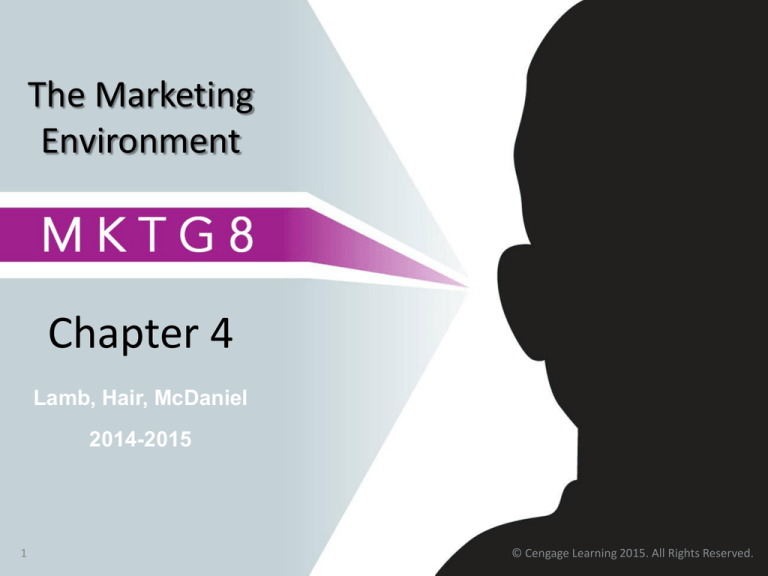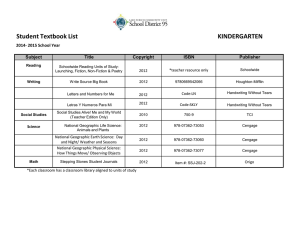
The Marketing
Environment
Chapter 4
Lamb, Hair, McDaniel
2014-2015
1
© Cengage Learning 2015. All Rights Reserved.
• Discuss the external environment of marketing and its
influence on marketing. They include: demographic,
economic, social, political, legal, technological, and cultural
factors
• Understand that they are external to the firm and mostly
uncontrollable
© 2015 Cengage Learning Inc. All Rights Reserved
2
The External
Marketing Environment
Discuss the external
environment of marketing,
and explain how it affects a
firm
1
3
© 2015 Cengage Learning Inc. All Rights Reserved
The Marketing Environment
Product
Price
Promotion
Place
Environment and Marketing Mix
Product
Environment
Economic
Competitive
Technological
Demographic
Geographic
Cultural
Political/legal
Price
Promotion
Place
Social Factors Affecting Marketing
• Values, Attitudes and Lifestyles (VALS)
• Core American Values: Self-sufficiency, Upward Mobility,
Work Ethic, and Conformity
• How social media have changed our behavior: Facebook,
LinkedIn, Twitter, Pinterest, Instagram, YouTube, Google+
etc.
• How firms use social media
• Changing role of women in a society
• Marriage as an institution
• Family as a unit of consumption
Demographic Factors Affecting
Marketing
• Population, age pyramid and birth rate
• Classification of American Society by Age
–
–
–
–
–
Tweens (8-12)
Teens (13-19)
Generation Y (born between 1979-1994)
Generation X (born between 1965-1978)
Baby Boomers (born between 1946-1964)
• Growth of the Ethnic Markets-Hispanic, African,
Asian Americans
Economic Factors Affecting
Marketing
• Disposable and discretionary income, debt and
savings
• Purchasing power parity
• Inflation
• Recession
• Business cycle
Technological Factors Affecting
Marketing
• How technology affects marketing
• Basic and applied research
• Marketers use Internet and Blogs to understand
consumer preferences
• Technology helps a company stay ahead in
competition (continuous innovation)
Political/Legal Factors Affecting
Marketing
• Why companies care about Politicians
–
–
–
–
Politicians make laws, lobbyists help business
Governments as a customer
Political officials can assist in securing business
Protect company interests through campaign donations
• Federal Legislation, State Laws, Regulatory Agencies
(Exhibit 4.1 and 4.2)
– Competitive Issues
– Consumer protection
– Business regulation
Demographic Factors
People are the basis for any market
• Demographic characteristics relate
to buyer behavior
• Demographic cohorts have their own
needs, values, and consumption
patterns.
3
© 2015 Cengage Learning Inc. All Rights Reserved
11
Tweens
Pre- and early adolescents, age
eight to twelve
Population of 20 million
Directly spend about $30 billion
annually
Parents spend $180 billion on
tweens annually
3
Respond very favorably to having
control over their own experiences
© 2015 Cengage Learning Inc. All Rights Reserved
12
Teens
Population of about 25 million
95 percent of U.S. Teens are on
the Internet
View shopping as a social sport
75 percent of teens are into social
networking
3
On average, just over $156 is
spent on or by every American teen
each week
© 2015 Cengage Learning Inc. All Rights Reserved
13
Generation Y
• Born between 1979 and 1994
• Surpassed population of baby boomers
• Two Stages: 1) Those born in 1994 fit
closer to the Teen cohort. 2) Those born
in 1979 have established careers and
started families.
• Purchasing power of $200 billion
annually
3
© 2015 Cengage Learning Inc. All Rights Reserved
14
Generation X
• Born between 1965 and 1978
• Population of 50 million
• Independent, resilient, adaptable,
cautious, and skeptical
• Gen Xers face a 59 percent decline in
net worth from 2005 to 2010
3
• Xers spend 62 percent more on housing,
50 percent more on apparel, and 27
percent more on entertainment
© 2015 Cengage Learning Inc. All Rights Reserved
15
Baby Boomers
• Born between 1946 and 1964
• Boomers are carrying substantial
financial burdens, including their
children’s educations, mortgages, and
health care
• Boomers spend $1.8 trillion annually
on food, cars, personal care, and other
personal products
3
• Boomers are willing to change brands
and try new things
© 2015 Cengage Learning Inc. All Rights Reserved
16
Growing Ethnic Markets
4
•
The United States Hispanic consumer
market is now larger than all but 13 world
economies
•
African American buying power increased
73 percent between 2000 and 2012
•
Asian American buying power increased
165 percent between 2000 and 2012
•
About one in three U.S. residents is a
member of a minority group
•
The United States will flip to majorityminority completely in 2041
© 2015 Cengage Learning Inc. All Rights Reserved
17
Marketing to
Hispanic Americans
4
The term Hispanic encompasses people
of many different backgrounds
Nearly 60 percent of Hispanics are of
Mexican descent
The diversity of the Hispanic population
and the language differences create many
challenges for those trying to target this
market
Hispanics, especially recent immigrants,
often prefer products from their native
country
© 2015 Cengage Learning Inc. All Rights Reserved
18
Marketing to
African Americans
• 47 percent of African Americans
are between 18 and 49 years old
•
More firms are creating products
for the African American market
•
In 2012, there were 2.8 million
African Americans earning more
than $75,000 annually
4
© 2015 Cengage Learning Inc. All Rights Reserved
19
Marketing to
Asian Americans
4
•
The Asian American population is the
fastest growing among minority groups
•
It quadrupled to about 17 million between
1980 and 2012
•
Although Asian Americans embrace the
values of the larger U.S. population, they
also hold on to the cultural values of their
particular subgroup
•
Asian Americans like to shop at stores
owned and managed by other Asian
Americans
© 2015 Cengage Learning Inc. All Rights Reserved
20
Consumers’ Incomes
•
•
•
Median U.S. household income
in 2012 was approximately
$50,000
Average family incomes, when
adjusted for inflation, fell around
eight percent between 2007 and
2011
Education is the primary
determinant of earning potential
5
© 2015 Cengage Learning Inc. All Rights Reserved
21
Purchasing Power is…
measured by comparing
income to the relative cost
of a standard set of goods
and services in different
geographic areas, usually
referred to as the cost of
living.
5
© 2015 Cengage Learning Inc. All Rights Reserved
22
Inflation is…
a measure of the decrease in
the value of money, expressed
as the percentage reduction in
value since the previous year.
5
© 2015 Cengage Learning Inc. All Rights Reserved
23
A recession is…
a period of economic activity
characterized by negative
growth, which reduces
demand for goods and
services.
5
© 2015 Cengage Learning Inc. All Rights Reserved
24
Research
Pure research that aims to
confirm an existing theory or
Basic Research to learn more about a
concept phenomenon.
Applied
Research
An attempt to develop new
or improved products
6
© 2015 Cengage Learning Inc. All Rights Reserved
25
Stimulating Innovation
Build scenarios
Enlist the Web
Talk to early adopters
Use marketing research
Create an innovative environment
Cater to entrepreneurs
6
© 2015 Cengage Learning Inc. All Rights Reserved
26
Political and Legal Factors
Laws and Regulations Protect:
New technology
Society
Businesses
Consumers
7
© 2015 Cengage Learning Inc. All Rights Reserved
27
Federal Legislation
Regulate
competitive
environment
•
•
•
•
•
•
Sherman Act
Clayton Act
Federal Trade Commission Act
Celler-Kefauver Antimerger Act
Hart-Scott-Rodino Act
Foreign Corrupt Practices Act
Regulate
pricing
practices
Robinson-Patman Act
Control
false
advertising
Wheeler-Lea Act
7
© 2015 Cengage Learning Inc. All Rights Reserved
28
State Laws
•
Legislation that affects marketing
varies state by state. For example:
•
•
•
7
Oregon limits utility advertising to 0.5
percent of net income
California has enacted legislation to
lower the energy consumption of
refrigerators, freezers, and air
conditioners
California and North Carolina, are
considering a tax on all in-state
commercial advertising
© 2015 Cengage Learning Inc. All Rights Reserved
29
Regulatory Agencies
Consumer
Product Safety
Commission
Protects consumer safety in
and around their homes
Food & Drug
Administration
Enforces safety regulations
for food and drug products
Federal Trade
Commission
Prevents unfair methods of
competition in commerce
7
© 2015 Cengage Learning Inc. All Rights Reserved
30
Bureaus of the FTC
Bureau of
Competition
• Reviews mergers and acquisitions
• Challenges anti-competitive
conduct
• Promotes competition
• Provides information
Bureau of
Consumer
Protection
• Enforces federal laws that protect
consumers
• Empowers consumers with
information
• Communicates with consumers
about fraud and identity theft
7
© 2015 Cengage Learning Inc. All Rights Reserved
31
Consumer Privacy
Government Actions
CAN-SPAM Act
Children’s Online Privacy Protection
Act Rule
7
Despite federal efforts, online tracking is
on a tear. A vast amount of personal data
is collected through apps.
© 2015 Cengage Learning Inc. All Rights Reserved
32
Competitive Factors
How many competitors?
Control
How big are competitors?
How interdependent is
the industry?
8
© 2015 Cengage Learning Inc. All Rights Reserved
33
Competitive Factors
Global Competition
Market Share
and Profits
• More foreign firms
• Firms must work
are entering U.S.
harder to maintain market.
profits and market
share.
• Foreign firms in
U.S. now compete
on product quality.
8
© 2015 Cengage Learning Inc. All Rights Reserved
34
Ch 4: Discussion Questions
1. Explain the influence of macro
environment in marketing.
2. Explain how social and demographic
factors influence marketing (or, you can
be asked to explain the influence of any
one of the environmental factors).
3. Discuss the influence of multiculturism
and growing ethnic population in
marketing in America.




